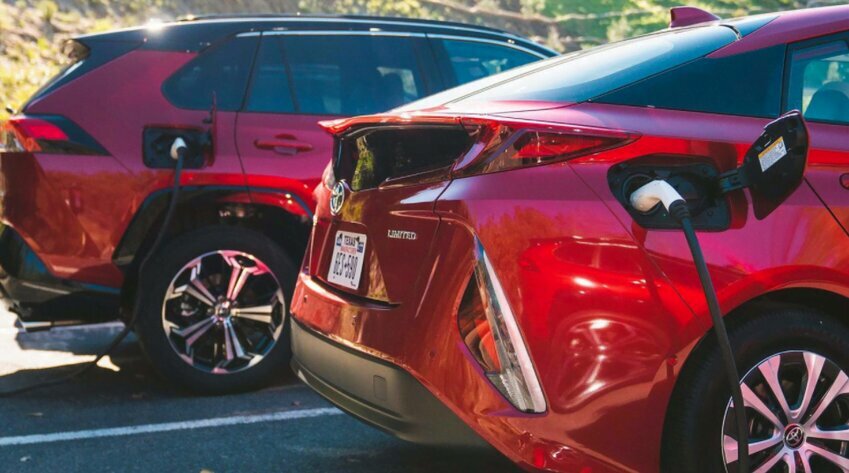 (Credit: Toyota)
(Credit: Toyota)Toyota may be best known for bringing the Prius to the forefront of the hybrid market. Electric vehicles are its focus, although the carmaker puts the peddle to the metal regarding hydrogen fuel cell cars. The company's chief executive, Koji Sato believes hydrogen is vital to global net zero goals.
Electric vehicles have a head start and the inside track in the sustainable car market. Plus, they have the infrastructure to support continued growth -- one that service the corporate EV fleet. But global policymakers also recognize hydrogen fuel cell cars for their zero emissions. And they can run much further than EVs before refueling is required — a process that takes just 10 minutes instead of 45 minutes.
"We want to ensure that hydrogen stays a viable option,” Sato said at an automotive conference as quoted by Automotive News. “We need a production and transport supply chain. Unless we see evolution there, we cannot expect a volume increase in the energy's use.” The company’s hydrogen vehicle, Mirai, has been around since 2014. But it is unveiling a new model this autumn.
No doubt, Toyota earned a lot of stripes with the Prius. And now, it aims to sell 3.5 million EVs globally by 2030. But Sato says the company’s ultimate success depends on selling EVs and hydrogen fuel-cell cars.
Electric vehicles comprise 2% of the global car market. The U.S. Energy Information Administration says hybrids that run on electricity and gas will make up 34% of cars in developed countries and 28% in emerging economies by 2050.
The advisory firm Wood MacKenzie adds that electric batteries will hit an inflection point in 2027 — where the economies of scale are at a place where price and quality are improving at an expedited pace. The electric vehicle rollout will then be unstoppable.
Pure hydrogen is stored in a tank before it is piped to a fuel cell to create clean electricity. Fuel cells will be cheaper than a Toyota Corolla engine, says Mike Strizki, owner of the Hydrogen House, in an interview with this writer. That’s because they will no longer need platinum, which makes the electrolyzer cheaper. This critical device creates an electric current to split the hydrogen and oxygen apart. While he thinks those costs will quickly fall, others say it will take time and that the price of an electrolyzer has to drop from $840 per kilowatt to $420 per kilowatt. That could happen in 2040, not 2030.
Policymakers are keen to create a demand for alternatively-fueled cars. In the United States, the Inflation Reduction Act provides a $7,500 tax credit for EVs beginning in 2023, and it will last a decade. This benefit had previously gone away if the car manufacturer sold more than 200,000 vehicles. It also includes a tax credit for clean hydrogen production — as much as $3 a kilogram. It provides a $7,500 tax credit for hydrogen fuel cell cars.
Hydrogen can run everything from vehicles to factories to power plants. In the case of cars, it is safer than gasoline, lighter than air, and easily maintained. And one hydrogen station can service 400 vehicles a day with 10-minute fill-ups.
Hydrogen-fueled cars have some advantages over EVs. They can run for 300 miles, and fueling up takes far less time than EVs, which can go about 200 miles and take 45 minutes. They also lose range in cold weather. But hydrogen cars do not. Most importantly, the exhaust gas from a hydrogen engine consists of pure water vapor. It is, therefore, emissions-free.
However, hydrogen loses as much as 70% of its energy content when it is produced and transported. Even hydrogen’s most ardent advocates acknowledge that significant energy losses occur when hydrogen is produced and transported. However, Strizki says all this is irrelevant if the price of hydrogen becomes cheaper than a gallon of gasoline and if the hydrogen is produced from accessible, renewable sources, referred to as “green hydrogen.”
“With so much renewable energy, who cares if hydrogen production is inefficient,” he says. “Free is still free. We can do seasonable energy storage and pump the hydrogen into the existing pipelines — as much as 20%. Once the infrastructure gets in place, we will be hard-pressed to resume burning carbon. With renewable energy, you never drill a dry hole. Right now, renewables are cheaper, and energy storage makes it viable.”
European oil giants BP, Repsol, and Royal Dutch Shell have money invested in the hydrogen supply chain. ExxonMobil Corp. is in as well. Indeed, the oil industry’s pipelines can carry hydrogen and its products.
Circling back to Toyota, it has sold just 21,700 hydrogen-fueled cars despite increasing its production capabilities. The primary reason is the limited fueling infrastructure, mainly located in California.
“Although hydrogen prices varied wildly, they were stable. Hydrogen is dispensed by the kilogram, and it takes 5.5 kg to fill the 2021 Mirai's tank,” writes Aaron Gold in MotorTrend. “The stations we visited charged anywhere from $13.14 to $18.69 per kg, but those prices never seemed to change, not even when gasoline prices skyrocketed in 2022. Filling up from a quarter tank generally cost between $45 and $50.”
He adds that is less than gasoline for a small, although far more than an electric vehicle. “Everyone who drove our Mirai agreed it was a lovely car… at least when it had full hydrogen tanks … hydrogen fuel cell vehicles would still face the cramped-interior problem, since those big tanks need to go somewhere.”
Corporate fleets need to make some significant notches in their net-zero goals. To that end, EVs are their quickest bet -- and one that comes with the infrastructure to service them.